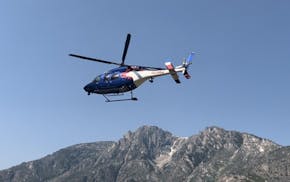In a first-of-its-kind script, earthquake scientists have created a realistic scenario of a 7.8 magnitude quake unzipping California's mighty San Andreas Fault near Los Angeles, where it's most primed to break. The scenario, developed for preparedness planning, is to be released today in Washington by the U.S. Geological Survey and California Geological Survey. Researchers caution that it is not a prediction; still, the possibility of a major California quake is very real. THE DAMAGE TALLY
• In less than 2 minutes, Los Angeles and its sprawling suburbs are shaking like a bowl of jelly. But the jolt then lasts another full minute -- 15 times longer than the disastrous 1994 Northridge quake.
• Water and sewer pipes crack. Power fails. Parts of major highways break. Some high-rise steel frame buildings and older concrete and brick structures collapse.
• Hospitals are swamped with 50,000 injured.
• Estimated dead: 1,800. Only about 700 are victims of building collapses. Many others are lost to the 1,600 fires burning across the region -- too many for firefighters to tackle at once.
• The fires destroy 200 million square feet of housing and residential properties worth $40 billion to $100 billion.
• The damage to the economy hits $200 billion -- on par with the Sept. 11, 2001, attacks and Hurricane Katrina.
COMPARED WITH CHINA
The figures are based on the assumption that California takes no continued action to retrofit flimsy buildings or update emergency plans. The projected loss is far less than the magnitude-7.9 killer that caused more than 40,000 deaths last week in western China, in part because California has stricter building code enforcement and retrofit programs.
THE CHANCES
Last month, the U.S. Geological Survey reported that the Golden State has a 46 percent chance of a 7.5 or larger quake in the next 30 years, and that such a quake probably would hit Southern California. The 1994 Northridge quake, which killed 72 people and caused $25 billion in damage, was much smaller at magnitude 6.7. "We cannot keep on planning for Northridge," said USGS seismologist Lucy Jones. "The science tells that it's not the worst we're going to face."
THE LESSONS
"We're going to have to think about out-of-the-box solutions," said Larry Collins, captain of the Urban Search & Rescue Task Force at the Los Angeles County Fire Department.
FOR MORE INFORMATION
The scenario will be released today at a House Subcommittee on Energy and Mineral Resources meeting. For more details, go to www.usgs.gov.
ASSOCIATED PRESS

JD Vance, an unlikely friendship and why it ended

Lewis Lapham, editor who revived Harper's magazine, dies at 89

Body of missing Minnesota hiker recovered in Beartooth Mountains of Montana
Mike Lindell and the other voting machine conspiracy theorists are still at it

